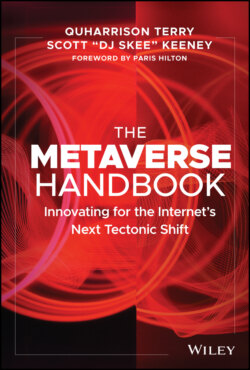Читать книгу The Metaverse Handbook - QuHarrison Terry - Страница 6
CHAPTER 1 A Vision for the Metaverse in 2032
ОглавлениеCoca-Cola lovers will have a new place to hang out starting today and…can set up a virtual alter ego known as an avatar, which can then shop and dance at the Coca-Cola diner, visit a movie theater to watch short films, and soar around on a hoverboard.
Coca-Cola's CC Metro, an online island shaped like a Coke bottle within a larger virtual world called There.com, showcases a vision of the shared Metaverse where brands give their customers a virtual playground to explore, play games, meet people, and ultimately shop. It's a vision that is shared by many corporations and has recently gained a lot of steam. However, the aforementioned announcement of CC Metro is not from 2022. It's not even from this decade. Rather, that's a quote from The New York Times in 2007.
Before the digital aspect of our social lives was cemented on Facebook, Instagram, Twitter, and LinkedIn, there was a belief that social networks could and should be in 3D, virtual worlds featuring experiences much like the real world. Second Life and Habbo Hotel were onboarding hundreds of thousands of users. Disney jumped on the trend with their Club Penguin virtual environment. MTV created almost a dozen of these virtual worlds for each of their hit shows at the time. Second Life was getting investments from Internet visionaries, including Jeff Bezos, and partnering with brands such as Sony, Sun Microsystems, and Adidas for campaigns. Virtual existence was becoming a thing.
Although not as large as Second Life or Habbo Hotel, There.com was pioneering Metaverse economies right alongside them. There.com had their own virtual currency called Therebucks, which were converted at a rate of 1,800 Tbux to $1 USD. Tbux could be spent on houses, furnishings, and outfitting your avatar. There were ample activities ranging from training your virtual pet to racing vehicles to connecting with new friends over a game of cards. And communities were forming around special interests.
In the early part of the new millennium, it really looked like virtual existence would become a major part of our lives. That's why Coca-Cola invested in CC Metro. They even went so far as integrating the MyCokeRewards program into CC Metro, giving users a place to spend their rewards points. It didn't matter where your brand was showing up in these virtual worlds, just as long as you were there in some capacity—learning from this new behavior and testing ways to capitalize on it.
Ultimately, 2D social networks were more effective than virtual worlds at onboarding droves of users and providing instant gratification. As a result, it's Facebook, not Second Life or There.com, that is the nearly trillion-dollar social networking company.
